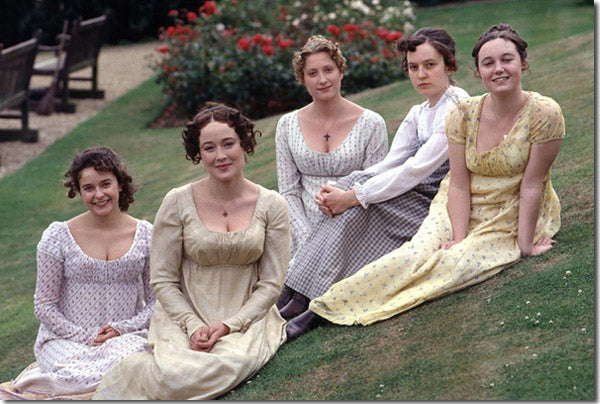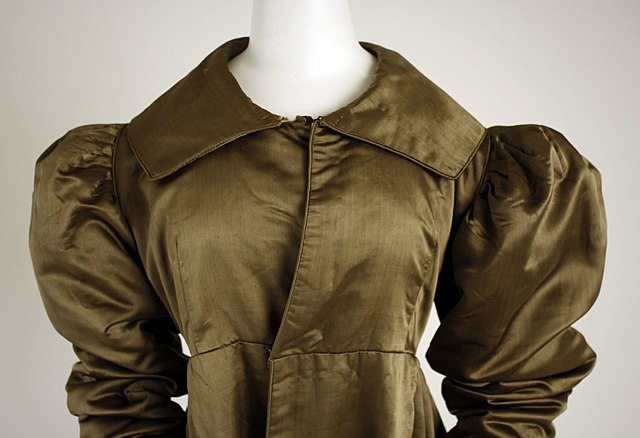Undress, Half Dress, Full Dress: Making Sense of It All
When Lydia went away, she promised to write very often and very minutely to her mother and Kitty; but her letters were always long expected, and always very short. Those to her mother contained little else, than that they were just returned from the library, where such and such officers had attended them, and where she had seen such beautiful ornaments as made her quite wild; that she had a new gown, or a new parasol, which she would have described more fully, but was obliged to leave off in a violent hurry, as Mrs Forster called her, and they were going to the camp; -- and from her correspondence with her sister, there was still less to be learnt -- for her letters to Kitty, though rather longer, were much too full of lines under the words to be made public.
Pride and Prejudice
 It means that there had to be a great many gowns in a genteel Regency lady's wardrobe--regardless of the size of her fortune. Indeed, to be active in Society the necessity of owning a large wardrobe could hardly be avoided. In a small town such as Longbourne (where the Bennets lived) the categories no doubt overlapped more than they would, say, for a debutante in London.
It means that there had to be a great many gowns in a genteel Regency lady's wardrobe--regardless of the size of her fortune. Indeed, to be active in Society the necessity of owning a large wardrobe could hardly be avoided. In a small town such as Longbourne (where the Bennets lived) the categories no doubt overlapped more than they would, say, for a debutante in London.- Morning dress
- Walking-out dress
- Carriage dress
- Promenade dress
- Afternoon dress
- Riding Habit
- Half-dress
See the difference?
In theory, you were in Undress in the morning, Half-dress in the afternoon, and Full Dress for evening events. Court Dress was also considered Full Dress, though it had extravagant requirements that no other occasion called for. According to The Georgian Index,* a wonderful online resource for Regency fans, Dinner Dress and Opera Dress fall into the category of "Half Dress." And only "Evening, Ball and Court Dresses" passed as Full Dress.
Is your head swimming, yet? If not, consider that the Riding Habit might not fit into any of the above, but simply constitute a category in its own right! Ah, so many dresses, so little time! No wonder the all-important Regency "season" was a roller-coaster ride of entertainments, diversions and delights. A lady must needs have enough events to make use of such an extensive wardrobe, and enough gowns in her possession to attend them in "the mode."
Pity the poor chit who couldn't follow protocol or dress for the occasion. Such was the challenge for families with more pretension than means, who wished to launch a Regency buck or belle into the swirl of the fashionable elite. The Regency. There's never been a time quite like it. You've got to love it!
Explore our costume section at our online shop for Regency clothing, patterns, and more!
Linore Rose Burkard is the Author/Editor of the monthly eZine, "Upon My Word! Facts, Fashion and Figures of the Regency.". Ms. Burkard is also the author of the Regency Romance, Before the Season Ends, a ground-breaking book which combines the Regency with Inspirational Romance! The sequel to this book, The House at Grosvenor Square will be published in 2009.
*Update 2021 : The Georgian Index is now defunct.


3 comments
Hi Linore,
What good timing! I’ve updated the link for you.
All my best,
Jenni
Anonymous
Links to pages with types of dress aren’t working on my computer.
Anonymous
Please note that the link beneath the article for my book, Before the Season Ends, is incorrect. A new edition of this book has just been released (only this week!) and can be seen at http://amzn.to/2H7eTLI.
Thanks,
Linore
Anonymous
Leave a comment
This site is protected by hCaptcha and the hCaptcha Privacy Policy and Terms of Service apply.